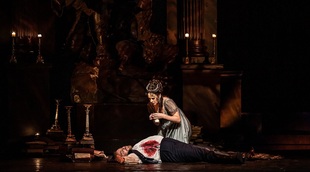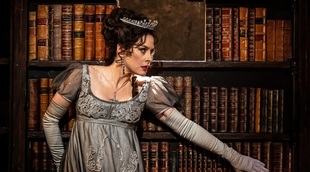 © Clive Barda
© Clive Barda
Based on Victorien Sardou’s 1887 French-language play, Giacomo Puccini’s Tosca of 1900, with a libretto by Luigi Illica and Giuseppe Giacosa, not only occurs in a specific time and place, but on a precise date that can be linked to an historical event. All of the action takes place during the afternoon, evening and early morning of 17 and 18 June 1800, following the Battle of Marengo between Napoleon’s army and Austrian forces. The Austrians were initially triumphant and sent news of victory back to Rome, but the city’s celebrations were cut short when a later report revealed that Napoleon subsequently mustered reinforcements and actually inflicted a crushing defeat.
Tosca is set across the hours when the contradictory messages arrive in Rome. Angelotti, a consul of the city when it was a republic but a prisoner since Neapolitan forces began to occupy it, escapes from the Castel Sant’Angelo and turns to the painter Cavaradossi to hide him. Rome’s Chief of Police, Baron Scarpia, attempts to squeeze information as to Angelotti’s whereabouts from Cavaradossi’s lover, the celebrated singer Floria Tosca. She is naturally prone to jealousy and Scarpia exploits this, as well as the situation as a whole in order to fulfil his own love for her.
After Scarpia sentences Cavaradossi to death for hiding a fugitive, Tosca promises to give herself to the Chief if he will release her lover and allow both of them to leave Rome. Scarpia agrees, explaining that he still needs to appear to have killed Cavaradossi, and so instructs his agent Spoletta to stage a mock execution by telling him to do as they did with Count Palmieri. As soon as Scarpia has written out their passport, however, Tosca stabs him to death. At the subsequent execution she discovers all too late that the Chief tricked her, and that Cavaradossi was shot with real bullets. As news of Scarpia’s murder spreads Tosca leaps off the parapet of the Castel Sant’Angelo and plunges to her death.
One of the most heart-wrenching aspects to Tosca is the very fact that a singer and painter who at the start of the story are simply going about their daily lives should find themselves thrust into a situation that spirals out of control so quickly that within twenty-four hours both are dead. Indeed, whether we assign the point of no return to Cavaradossi’s initial decision to help Angelotti, or to the moment when Tosca determines to head to his villa, which ultimately leads Scarpia’s forces to both men, their fates feel largely sealed by the end of Act I before the sun has even gone down.
Given the specific nature of the background events, Tosca is an opera that few directors choose to set in anything other than its original time and place. There have been some exceptions to this rule, but most departures, when occurring at all, have not been particularly large. Luc Bondy’s 2009 production for the Metropolitan Opera saw Richard Peduzzi’s sets imply a setting of 1930s fascist Italy, but beyond this did nothing to say we were not in the midst of the French Revolutionary Wars. Christof Loy’s recent production for English National Opera, which came from The Finnish National Opera and Ballet, opted for the original setting while also applying a twist. By putting the characters in costumes from a variety of eras, Loy suggested that there have been Scarpias exploiting Toscas at all moments in time, and highlighted the division between Cavaradossi’s revolutionary ideals and Scarpia’s reactionary approach.
Jonathan Kent’s production for the Royal Opera House, which started life in 2006 and is now enjoying its twelfth revival (from Simon Iorio), opts for the original setting in every way, and, by applying no obvious twists to the time and place, finds it far easier to drill down to what is actually in the opera itself. It consequently brings out the tragedy to the full as it sees every set work around some form of curve. Act I presents the shadowy side of Rome’s Sant’Andrea della Valle, with the Attavanti chapel where Angelotti initially hides lying both behind and below the church’s main altar. From the audience’s vantage point the nave and chancel stand above the stage, with marble columns and candles proclaiming beauty and light. In contrast, the lower level offers a ‘behind the scenes’ glimpse of the church, where different artistic and architectural styles vie for attention. There is an ancient Corinthian capital (upon which a statue of the Madonna stands), and the painting Cavaradossi is working on appears opposite the faded remains of a medieval Last Judgment fresco that presumably survives from an earlier church on the site.
It is within this more cluttered area that the church as an institution is shown to be imperfect, which in the context of the Neapolitan occupation derives from its virtual inseparability from police and state. During a recitation of the ‘Te Deum’ when the choir and crowd sing to the heavens above, Scarpia alone occupies the entire lower level revealing how, in practice, he rules over all three of these domains.
The late Paul Brown’s set actually places the church at a slight angle to the auditorium, and this asymmetrical trend is continued in Act II when Scarpia’s apartment in the Palazzo Farnese is based around two curves that cross one in front of the other. Interestingly, the only shelves to bear books at all are those that hide the room where Cavaradossi is tortured and even these turn out to be fake. Act III’s scene of execution on the ramparts of the Castel Sant’Angelo is dominated by a low curved parapet that only runs down one side of the stage, and creates a suitably hostile moonlit area.
The cast is excellent, and as each principal offers interesting perspectives on their own character they also provide new insights into the opera. As Tosca, Malin Byström’s immensely persuasive soprano works seamlessly with her portrayal of the character. This is not a Tosca whose jealous nature leads her to indulge in histrionics, or who always tinges her demands with humour so as to lighten the mood because she knows what she is like. Rather, she is someone who is genuinely hurt by any thought that Cavaradossi may be unfaithful so that, while outwardly she still maintains her composure, inside it is clear that the thought cuts her to the quick. Her performance of ‘Vissi d’arte’ is particularly powerful in terms of its impact as she begins it before a statue in the Palazzo Farnese and then slowly moves towards us and kneels.
Gwyn Hughes Jones is an excellent Cavaradossi, with his ringing tenor being both large and expansive. If a few lines in ‘Recondita armonia’ feel just a little raw, it is not a problem that persists, and his performance of ‘E lucevan le stelle’ is one of the undoubted highlights of the evening. Hughes Jones also embodies every facet of Cavaradossi’s character so that his support for the ideals of the republic feels like a very part of his being.
This production works to the idea that in Act III Cavaradossi realises that Scarpia must have double-crossed Tosca, and that he will be shot with real bullets. He does not believe Tosca has any chance of surviving either because the Chief’s body will be discovered soon enough. If he did, he would be urging her to flee immediately, but, believing her to be doomed, he encourages her to picture their future happiness so that her final moments can be happy ones. Interestingly, however, the point has been rendered differently in the various revivals. In 2019 when Tosca showed Cavaradossi their passport he crushed it with his foot when he believed that she had slept with Scarpia in order to obtain it. However, once he discovered the truth he made no effort to retrieve it because he knew they would never get to the point of needing to use it. In 2021 Cavaradossi retained the passport until far later so that it was only when Tosca actually described how he would be shot with dummy bullets that he threw it away, having worked out that they would be anything but. On this occasion, there is no similarly bold gesture as Tosca retains the passport throughout the scene, but there does not need to be as Hughes Jones’s expressions alone make clear what he is thinking. Interestingly, once Cavaradossi has been shot, a soldier moves to stab his body but is stopped by Spoletta because it is part of the ‘Count Palmieri’ procedure to maintain a pretence by not ‘finishing off’ the person in this way.
Asserting his strong baritone to excellent effect, Gabriele Viviani is a highly intriguing Scarpia. His brutality and cruelty are not shown as overtly as in some assumptions of the role, but, if anything, this only makes his presence even greater because he is able to come across as a charmer. Viviani also reveals how the Chief of Police actually feels vulnerable by being so intoxicated by Tosca. This is because it is a shock to a man who is so used to controlling everything around him to discover that he cannot actually control himself. In the pit, Daniel Oren offers an incredibly monumental interpretation of the score with moments such as Scarpia’s first appearance, the stabbing of the Chief of the Police and Tosca’s discovery that Cavaradossi is dead feeling particularly dramatic. Perhaps by the same token, his approach is not always the best at capturing the sweeping nature of Puccini’s score, but there is always going to be a trade-off between the two and this is by any measure a fascinating rendering of it. The performances from 12 December onwards see Natalya Romaniw play Tosca, Freddie De Tommaso sing Cavaradossi and Erwin Schrott assume the role of Scarpia.
By Sam Smith
Tosca | 28 November – 21 December 2022 | Royal Opera House, Covent Garden
the 06 of December, 2022 | Print


Comments